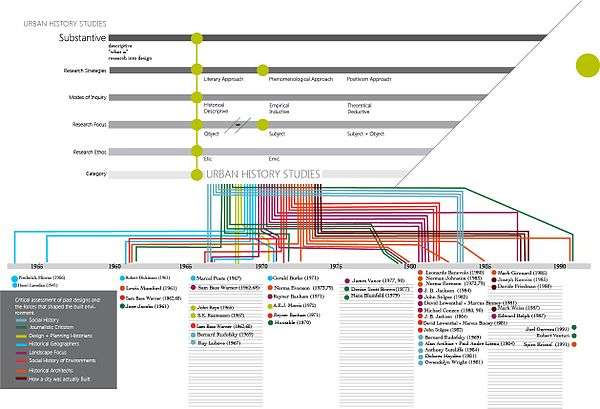Urbanism
Urbanism is the study of the characteristic ways of interaction of inhabitants of towns and cities (urban areas) with the built environment. It is a direct component of disciplines such as urban planning (the physical design and management of urban structures) and urban sociology (the study of urban life and culture). However, in some contexts internationally Urbanism is synonymous with Urban Planning, and the Urbanist refers to a Urban Planner.
Many architects, planners, and sociologists investigate the way people live in densely populated urban areas. There is a huge variety of approaches within urbanism.[1]
Urbanism's emergence in the early 20th century was associated with the rise of centralized manufacturing, mixed-use neighborhoods, social organizations and networks, and what has been described as "the convergence between political, social and economic citizenship".[2]
Urbanism can be understood as placemaking and the creation of place identity at a city-wide level, however as early as 1938 Louis Wirth wrote that it is necessary to stop 'identify[ing] urbanism with the physical entity of the city', go 'beyond an arbitrary boundary line' and consider how 'technological developments in transportation and communication have enormously extended the urban mode of living beyond the confines of the city itself.' [3]
Concepts

Network-based theories
Gabriel Dupuy applied network theory to the field of urbanism and suggests that the single dominant characteristic of modern urbanism is its networked character, as opposed to segregated conceptions of space (i.e. zones, boundaries and edges).[4]
Stephen Graham and Simon Marvin argue that we are witnessing a post-urban environment where decentralized, loosely connected neighborhoods and zones of activity assume the former organizing role played by urban spaces. Their theory of splintering urbanism involves the "fragmentation of the social and material fabric of cities" into "cellular clusters of globally connected high-service enclaves and network ghettos" driven by electronic networks that segregate as much as they connect. Dominique Lorrain argues that the process of splintering urbanism began towards the end of the 20th century with the emergence of the gigacity, a new form of a networked city characterised by three-dimensional size, network density and the blurring of city boundaries.[5]
Manuel Castells suggested that within a network society, "premium" infrastructure networks (high-speed telecommunications, ‘smart’ highways, global airline networks) selectively connect together the most favored users and places and bypass the less favored.[5] Graham and Marvin argue that attention to infrastructure networks is reactive to crises or collapse, rather than sustained and systematic, because of a failure to understand the links between urban life and urban infrastructure networks.
Pragmatism
The philosophical movement called pragmatism, which asserts that most philosophical topics are best viewed in terms of their practical uses and successes, emerged at roughly the same time as urbanism and pragmatists and urban practitioners have influenced each other.
Part of the philosophy of William James, one of the founding fathers of pragmatism, was to encourage people to actively reach out to the points where they can critically engage with others. The theme of democracy was also central to John Dewey's version of pragmatism. He believed that in a democratic society, every sovereign citizen is capable of achieving personality. He argued that the concept of place should be open to experimentation for the hope of realising a better world.[6]
According to Richard J. Bernstein, "these themes are also basic applications of urbanism". Under pragmatism, place is defined throughout continuous interactions with its dwellers, therefore there cannot be a platonic ideal of placeless or an essential definition of place. This approach can be seen in the theory of placemaking that emerged in the 1960s, epitomised by Jan Gehl's quote "First life, then spaces, then buildings – the other way around never works".[7]
Anti-foundationalism and fallibilism are related to pragmatism. In the context of those, pragmatists argue that the idea of space needs to be able to cope with unpredictability and change. The notion of a community as inquirers emphasises that the idea of place will be sustained only as long as there is a community to support it.
Other modern theorists
Douglas Kelbaugh identifies three paradigms within urbanism: New Urbanism, Everyday Urbanism, and Post-Urbanism.[8]
Paul Knox refers to one of many trends in contemporary urbanism as the "aestheticization of everyday life".[9]
Alex Krieger states that urban design is less a technical discipline than a mind-set based on a commitment to cities.[10]
See also
- Ecological urbanism
- Green urbanism
- Landscape urbanism, an urbanism modeled on the disciplines of landscape architecture and ecology
- New urbanism, a response to contemporary problems such as urban sprawl and traffic congestion
- Unitary urbanism, a critique of urbanism as a technology of power by the situationists
- Sustainable Urbanism
- Urban geography
- Urban design
- Urban planning
- Principles of Intelligent Urbanism
- Urbanate, a living environment envisioned by the Technocracy movement
- World Urbanism Day
- MONU - magazine on urbanism
Endnotes
- ↑ Jonathan Barnett, “A Short Guide to 60 of the Newest Urbanisms,” Planning volume 77 (2011-4) 19-21
- ↑ Blokland-Potters, Talja, and Savage, Mike. (2008). Networked Urbanism: Social Capital in the City. Ashgate Publishing.
- ↑ Wirth, Louis. 1938. Urbanism as a Way of Life. The American Journal of Sociology, volume 44, number 1: pages 1-24. July.
- ↑ Dupuy, Gabriel. (2008). Urban Networks – Network Urbanism. Amsterdam: Techne Press.
- 1 2 Graham, Stephen, and Marvin, Simon. (2001). Splintering Urbanism : Networked Infrastructures, Technological Mobilities and the Urban Condition. London, UK: Routledge.
- ↑ Bernstein, Richard J. The pragmatic turn. Cambridge: Polity, 2010. ISBN 978-0745649085
- ↑ "Jan Gehl - Project for Public Spaces". Project for Public Spaces. Retrieved 2016-06-16.
- ↑ Kelbaugh, Douglas, 2009, Three Urbanisms and the Public Realm
- ↑ Knox, Paul, 2010, Cities and Design, page 10.
- ↑ Krieger, Alex, 2009, Urban Design, page 113.
External links
- International Forum on Urbanism
- Aseem Inam, Designing Urban Transformation New York and London: Routledge, 2013. ISBN 978-0415837705.
